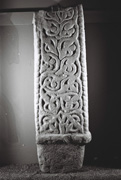Select a site alphabetically from the choices shown in the box below. Alternatively, browse sculptural examples using the Forward/Back buttons.
Chapters for this volume, along with copies of original in-text images, are available here.
Object type: Part of shaft
Measurements: H. 118 cm (46.5 in); W. (base) 32 cm (12.5 in); collar 40 cm (15.75 in); top 34 cm (13.5 in); D. (base) 16 cm (6.5 in); (collar) 18 cm (7 in); top 18 cm (7 in)
Stone type: Pale yellowish brown (10YR 6/2), well-sorted, clast-supported, quartz sandstone; the clasts vary from sub-angular to sub-rounded, but are mostly sub-rounded; they range from fine-grained (0.2 mm) to medium-grained (0.3 mm). Millstone Grit, Carboniferous
Plate numbers in printed volume: Ills. 391-5
Corpus volume reference: Vol 9 p. 159-160
(There may be more views or larger images available for this item. Click on the thumbnail image to view.)
A brass plate, fixed to the top of the stone in 1891 by Jonathan Peel reads: 'This stone, found in the Accrington House grounds in 1847, is supposed to have formed the shaft of the cross that once stood in front of Peel Fold'. The metal plate then identifies Peel Fold as 'an ancient house formerly known as 'Oldham's Cross' or simply as 'The Cross', which was purchased by Robert Peele probably about the year 1685...'. In an article in the Preston Guardian for 23 March 1878, the local historian W. A. Abrams added further information: 'The chief feature of interest at Peel Fold was an ancient cross which gave its original name to the place, of 'Oldham's Cross'. This cross formerly stood in front of the house, about 130 yards distant ... on a stone pedestal.' Abrams claims that the cross was pulled down 'some forty years ago' and the pedestal made into a rain-water trough; the cross itself had disappeared by the time Abrams was writing (Edwards, B. 1987a, 41–2).
If the identification of this stone with 'Oldham's cross' is accepted, then the likely nineteenth-century history of the carving can be reconstructed as: (a) sited at Oldham's Cross (SD 718279); (b) removed in c. 1838; (c) taken to Accrington House (SD 767288) which belonged to the Peel family; (d) later removed to Knowlmere Manor after the demolition of Accrington House in the late nineteenth century.
In some of the literature this sculpture is listed under Oswaldtwistle.
The shaft carries decoration in a single panel on all four faces. The panels are framed laterally by a bold cable moulding; a broad encircling moulding separates these panels from an undecorated tenon below.
A (broad): Decoration consists of a complicated form of side-linked scroll springing from a single stem. Balanced side shoots terminate in a fruit/leaf roundel (some with scooped centres) which is flanked by paired foliate forms with prolonged tips. These fruit/leaf forms are enclosed within an encircling stem and one of the two leaves is extended to form a further stem.
B (narrow): A single panel carries a complex meander pattern, possibly based upon Romilly Allen no. 903 (Allen and Anderson 1903, ii, 334) but with differing links.
C (broad): Decoration consists of a form of side-linked scroll springing from a single stem, less complex than on face A. Flanking the base are triple plain rounded leaves whilst, further up, the shoots (after crossing each other) terminate in backward-turned pelta-like spirals, some of which seem to carry contouring forms running parallel with the spiral.
D (narrow): Open four-strand basket-plait
This is a very accomplished carving. Its bold lateral mouldings and the encircling collar at the base are repeated within a group of carvings from Whalley, Anderton and Bolton, crosses which also favour runs of meander pattern on the narrow face; this appears to represent a regional taste (Ills. 401–4, 409–12, 675–8). The full-length meander pattern is exactly matched on a Viking-age shaft at Penmon (Nash-Williams 1950, no. 38, pl. XXXI), and its combination here with a simple four-strand plait therefore suggests a tenth-century date for the carving.
The two full-length panels of scroll, with their complex of interlacing stems, clearly derive however from earlier Anglian art, though here, particularly on face A with its foliate extensions, they represent a novel approach to well-established themes: Walton on the Hill 1 shows an analogous development (Ills. 653–6). The basis of this kind of scroll leads back to eighth-century work at Hexham, and the treatment here can best be paralleled (though without the foliate joins) on the ninth-century shaft at Nunnykirk, Northumberland (Cramp 1984, pls. 168.898, 209.1195). The earliest of the Pentney brooches and the grave-cover from Ramsbury, Wiltshire, show similar tastes for interlacing foliate forms in the ninth and tenth centuries (Wilson, D. M. 1984, ill. 120; Cramp 2006, 231, ill. 506). The pelta-like spiralling forms on face B are a familiar feature of western Northumbrian scrolls (Bailey and Cramp 1988, ills. 354, 437, 439).



